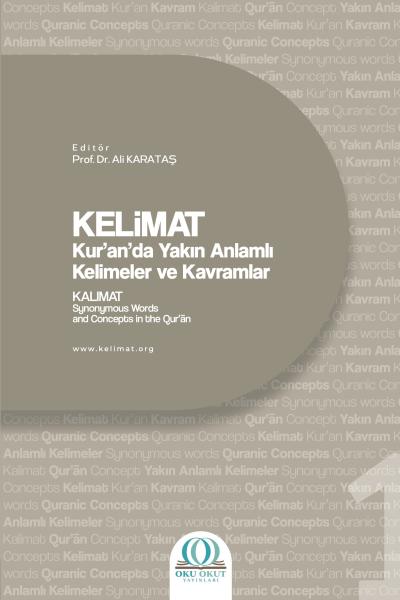Oku Okut Yayınları, kitabın yayım ve dağıtım hakkını saklı tutar. Ticari kullanım için yayınevine başvurulması gerekir.
Yazarlar
-
Prof. Dr. Ali Karataş (ed)https://orcid.org/0000-0003-3365-0627
Humans, by virtue of their unique characteristics, are capable of naming entities, events, and phenomena, and coining words. In this way, they continuously develop and keep language alive to both refer to the entities that hold a place in their lives and to make judgments about them. Thus, a direct and dynamic relationship is established between language and life. In this context, in order to properly establish the relationship between the Qur’an and life, it is essential to understand the meanings of words.
Many words in the Qur’an exhibit semantic proximity; however, they differ from one another in various respects and point to distinct aspects. If such distinctions are not identified, the Qur’an risks being reduced to a text of mere synonyms. The way to avoid this is through accurate determination of word meanings.
Within the scope of the www.kelimat.org project, and by utilizing our primary sources, words in the Qur’an that can be grouped under specific headings have been identified and categorized into semantic groups. Based on the contextual usage of the words, attention has been given to highlighting the points at which they diverge from one another.
İnsanlar kendilerine has özellikleriyle varlık, olay ve olgular için isim koyabilmekte ve kelime vazʿ edebilmektedirler. Böylece hem hayatlarında yer tutan varlıklara işaret etmesi hem de onlar üzerinde yargılarda bulunabilmek için dili sürekli geliştirmekte ve canlı tutmaktadırlar. Böylece dil ve hayat arasında doğrudan ve canlı bir ilişki kurulmaktadır. Bu bağlamda Kur’ân ile hayat ilişkisinin doğru tesis edilebilmesi için sözcüklerin anlamına vakıf olmak elzem bir durumdur. Kur’an’da geçen pek çok kelime anlamsal yakınlığa sahiptir ancak bu kelimeler çeşitli açılardan birbirinden ayrılmakta ve farklı yönlere işaret etmektedir. Bu durum tespit edilmediğinde Kur’an âdeta eş anlamlılığa kurban edilmeyle karşı karşıyadır. Bundan kurtulmanın yolu ise sözcüklerin anlamını doğru tespit etmekten geçmektedir. www.kelimat.org projesi kapsamında temel kaynaklarımızdan istifade ile Kur’ân-ı Kerîm’de yer alan ve belli bir başlık altında bir araya getirilmesi imkân dâhilinde bulunan kelimeler tespit edilmiş ve anlam grupları oluşturulmuştur.Kelimelerin kullanımları dikkate alınarak varsa birbirlerinden farklılaştığı noktaların ele alınması hedeflenmiştir.
Telif Hakkı
Telif Hakkı (c) 2025 Oku Okut Yayınları
Lisans

Bu çalışma Creative Commons Attribution 4.0 International License ile lisanslanmıştır.
Yazar Biyografisi
-
Prof. Dr. Ali Karataş, Sakarya Üniversitesi
Amasya’nın Gümüşhacıköy ilçesinde doğdu (1977). İlk ve orta öğrenimini burada tamamladı (1994). On Dokuz Mayıs Üniversitesi İlahiyat Fakültesi’nden mezun oldu (1999). On yılı aşkın bir süre Milli Eğitim Bakanlığı’na bağlı okullarda öğretmen olarak görev yaptı. “Süleyman Ateş’in Yüce Kur’an’ın Çağdaş Tefsiri ve Tasavvufi Yönü” isimli tezi ile Dicle Üniversitesi Sosyal Bilimler Enstitüsü’nden yüksek lisans diploması aldı (2002). Ankara Üniversitesi Sosyal Bilimler Enstitüsü’nde “Mâtürîdî’nin Te’vilâtü’l-Kur’ân’ında Kur’ân’ı Kur’ân’la Tefsir” teziyle doktorasını tamamladı (2011). Bartın ve Pamukkale Üniversiteleri’nde çalıştı. Bu görevleri esnasında dekan yardımcılığı görevinde de bulundu. Kale Meslek Yüksekokulu müdürü olarak çalıştı. Şu an Sakarya Üniversitesi İlahiyat Fakültesinde görev yapmaktadır. Karataş’ın “İmam Mâtürîdî’nin Kur’ân Anlayışı ve Kur’ân’ı Kur’ân’la Te’vîl Yöntemi”, “Tefsir Geleneğinde Rivayet” ve "Anlamdan Yoruma Kur'an" adlı kitapları yayımlandı. Alanıyla ilgili kitaplarda bölümler yazdı. Editörlüğünde yayınlanan kitapları bulunan Karataş’ın, uluslararası ve ulusal hakemli dergilerde yayımlanmış makaleleri ve bildirileri bulunmaktadır. Tefsir Araştırmaları Dergisi’nin (TADER) editörlüğünü de yürüten Karataş, 04.04.2016 yılında doçent unvanını aldı ve 5 Temmuz 2021'de profesörlük kadrosuna atandı.
İndir
Yayın Bilgisi
-
Yayın TürüEditörlü Kitap
-
Yayım Tarihi16 Haziran 2025
-
Dizi
-
Dizi No.3
-
Kategori
-
ISBN-10 (02)625-97648-4-9
-
ISBN-13 (15)978-625-97648-4-9
-
Proprietary (01)34
-
Publication date (01)01.12.2024
Bu kitapla ilgili ayrıntılar
Karataş, Ali (ed.). Kelimat: Kur’an’da Yakın Anlamlı Kelimeler Ve Kavramlar. critical ed . Ankara: Oku Okut Yayınları, 2025. https://doi.org/10.55709/okuokutyayinlari.76












